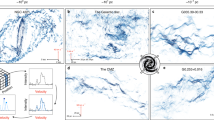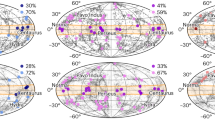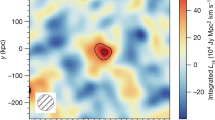Abstract
The galaxy peculiar velocity field (velocity relative to the uniform Hubble law expansion) seems to have a large r.m.s. value, ∼500 km s−1, and a large coherence length ≳=50 Mpc. It is difficult to account for this in the standard model inspired by inflation, where galaxies and clusters of galaxies grow by gravity out of initially adiabatic fluctuations in the distribution of mass now dominated by weakly interacting cold dark matter1,2. A model that does seem to work assumes that, at high redshift, mass was uniform and the baryon number was inhomogeneous, a stationary random process. This produces in the late Universe a baryon distribution with a power spectrum proportional to the initial value at short wavelength, a prominent peak in the spectrum at the matter-radiation Jeans length, and a sharp cutoff at longer wavelengths. Here I report how this spectrum normalized by the observed galaxy clustering can produce by gravity the large velocity field with large coherence length needed without excessively perturbing the microwave background.
This is a preview of subscription content, access via your institution
Access options
Subscribe to this journal
Receive 51 print issues and online access
$199.00 per year
only $3.90 per issue
Buy this article
- Purchase on Springer Link
- Instant access to full article PDF
Prices may be subject to local taxes which are calculated during checkout
Similar content being viewed by others
References
1. Vittorio, N., Juszkiewicz, R. & Davis, M. Nature 323, 132–133 (1986). 2. Bond, J. R. Galaxy Distances and Deviations from Universal Expansion (eds Madore, B. F. & Tully, R. B.) 255–263 (Reidel, Dordrecht, 1986). 3. Wilkinson, D. T. Science 232, 1517–1522 (1986). 4. Sandage, A. R. Astrophys. J. 307, 1–19 (1986). 5. Rubin, V. C., Ford, W. K., Thonnard, N., Roberts, M. S. & Graham, J. A. Astr. J. 81, 687–737 (1976). 6. Collins, A., Joseph, R. D. & Robertson, N. A. Nature 320, 506–508 (1986). 7. Burstein, D. et al. Galaxy Distances and Deviations from Universal Expansion (eds Madore, B. F. & Tully, R. B.) 123–130 (Reidel, Dordrecht, 1986). 8. Frenk, C. S., White, S. D. M., Efstathiou, G. & Davis, M. Nature 317, 595–597 (1985). 9. Peebles, P. J. E. The Early Universe (ed. Unruh, W. G.) (Reidel, Dordrecht, 1986). 10. Peebles, P. J. E. The Origin and Evolution of Galaxies (eds Jones, B. J. T. & Jones, J. E.) 143–169 (Reidel, Dordrecht, 1983). 11. Peebles, P. J. E. Astrophys. J. 248, 885–897 (1981). 12. Glutton-Brock, M. & Peebles, P. J. E. Astr. J. 86, 1115–1119 (1981). 13. Davis, M. & Peebles, P. J. E. Astrophys. J. 267, 465–482 (1983). 14. Peebles, P. J. E. Astrophys. J. (in the press).
Author information
Authors and Affiliations
Rights and permissions
About this article
Cite this article
Peebles, P. Origin of the large-scale galaxy peculiar velocity field: a minimal isocurvature model. Nature 327, 210–211 (1987). https://doi.org/10.1038/327210a0
Received:
Accepted:
Issue Date:
DOI: https://doi.org/10.1038/327210a0
Comments
By submitting a comment you agree to abide by our Terms and Community Guidelines. If you find something abusive or that does not comply with our terms or guidelines please flag it as inappropriate.



